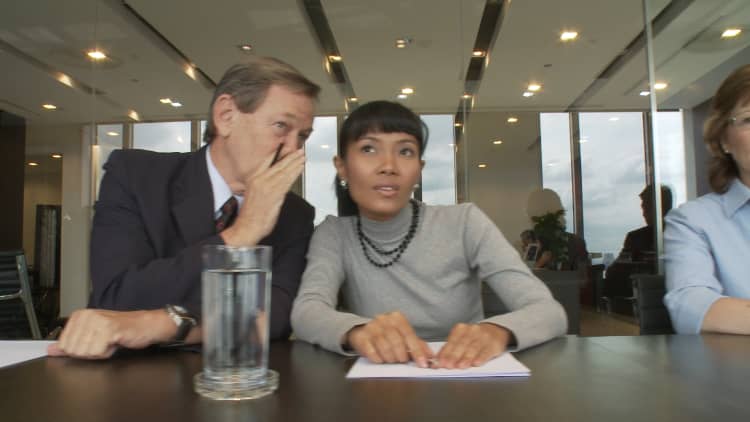What's black and white and read all over?
Your work-related emails. Every day. By co-workers and clients.
Each time you press send, you allow others to judge the style, quality and effectiveness of your writing. Let's be serious — we size up the communication skills of other people all the time.
More from Danny Rubin:
7 words you need to stop capitalizing
How to write the perfect LinkedIn profile summary
What a young professional resume should look like
"His email went on way too long."
"Her messages are difficult to understand."
"Emails from that company always feel like spam."
And the list of critiques goes on.
Then someone comes along and writes the "perfect" email. The content follows a logical process, every sentence is understandable and readers feel like their time is valued.
How do we reach "expert" status? We can start by fixing the six biggest work email mistakes.
1. Address the wrong person
To kick off the list, I present an obvious but easily overlooked faux pas. Make sure the e-mail recipient matches the person you address inside the email.
The mistake often happens when we send the same email to multiple people but need to swap out the name and/or company in the email body.
Be sure your email recipient matches the first name at the start of the email ("Hi, John"). You may even want to say each one out loud so you're sure of it. Sure beats sending an email to an important person but using someone else's name. Awkward.

2. Bury the lead
A well-known term among journalists, "burying the lead" (sometimes written as "lede") means to hide your main point deep in the article where it's hard to find.
The mistake is common in work emails too.
The key? Put your "ask" or main point near the top of the message. Yes, begin the email with small talk: "How's everything going at Acme Corporation?" But once the pleasantries are out of the way, get to business.
"I'm writing discuss a partnership between our companies as the busy spring season approaches."
When you start the email with your "ask," your message has context. Then the rest of the email supports the "ask." If the request comes too late, the recipient has no choice but to think, "What does this person want? I can't figure it out."
Put the "lead" at the top where the reader can find it.
3. Use terms and abbreviations people don't understand
Classic business writing fail. We use abbreviations and work lingo so readily with colleagues that we forget other people in an email chain may have no idea what we're talking about.
"Let's all meet at CDI in room 200 at 6:30 p.m. Oh, and don't forget to bring the building will be code green after 5:00 p.m."
Umm … what?
This is where "soft skills" come into play. Look at the list of email recipients and ask yourself, "Does everyone on here know what 'CDI' means?"

When in doubt, spell it out.
"Let's all meet at the Center for Division Intelligence offices in room 200 at 6:30 p.m. Oh, and don't forget the building will be code green after 5:00 p.m. For those who may not know, 'code green' means you need to be escorted by security."
Now, isn't that better?
4. Respond to emails in your head
Raise your hand if you've "answered" an email in your head. And in doing so, you said to yourself, "Case closed. I sent back a reply."
Nope. You didn't.
Meanwhile, the person sits on the other end hoping, wishing, waiting for a reply.
The gaffe is a real problem when people need a response ASAP. Your silence drives them crazy. "Why won't he just write me back? Did I do something to make him mad?"
At the same moment, you're in the office kitchen microwaving soup like you already sent off the email lickety split.
Bottom line: keep the emails out of your head and inside the computer.
5. Include giant paragraphs
When I edit for clients, I often come across wordy sections like this:
At Acme Corporation, we are experts at catering and event planning for the greater Los Angeles area. Since 1979, we have worked big and small events for companies, associations and large family gatherings. Our catering choices include breakfast, lunch, dinner, dessert, brunch and late-night food at the end of a wedding. If you need the perfect meal for a big occasion, we're the team for you.
When I see a big paragraph in an email or on a website, my instinct is to chop it down. Often, bullet points are the simplest way to make the copy more readable.
At Acme Corporation, we are experts at catering and event planning for the greater Los Angeles area. Since 1979, we have worked big and small events for companies, associations and large family gatherings. Our catering choices include:
- Breakfast
- Lunch
- Dinner
- Dessert
- Brunch
- Late-night food at the end of a wedding
If you need the perfect meal for a big occasion, we're the team for you.
There. Much better.
6. capitalize the Wrong words
I see people capitalize many words that feel important (like Leadership) but should instead be lowercase. We capitalize proper nouns ("Acme Leadership Institute").
Also, a special note on job titles.
Incorrect: I'm a Marketing Coordinator at Acme Corporation.
Correct: I'm a marketing coordinator at Acme Corporation.
Explanation: Job titles are lowercase unless they come before your name (Marketing Coordinator Jane Doe is…).
This article originally appeared on dannyhrubin.com.
Danny Rubin is the author of "Wait, How Do I Write This Email?" You can follow him on Twitter here.



